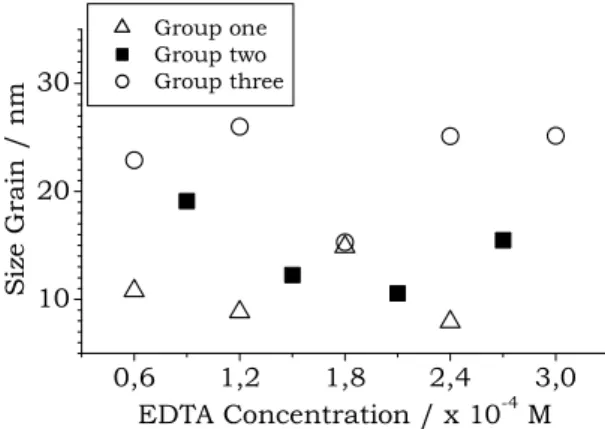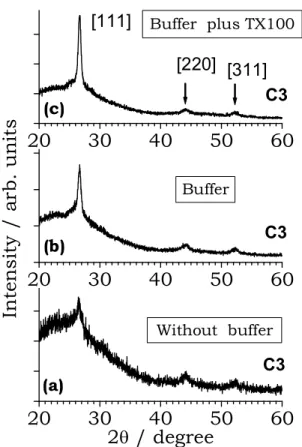656 Brazilian Journal of Physics, vol. 34, no. 2B, June, 2004
A New Route for Preparing CdS thin Films by Chemical
Bath Deposition Using EDTA as Ligand
A. V. Feitosa
‡, M. A. R. Miranda
†, J. M. Sasaki
†, and M. A. Ara´ujo-Silva
‡,
‡Lab. de Optoeletroqu´ımica e Lab. de Filmes Finos, Departamento de F´ısica,
Universidade Federal do Cear´a, Centro de Ciˆencias, Campus do Pici, Caixa Postal 6030, 60455-760 Fortaleza, Cear ´a, Brazil
†
Lab. de Raios X, Departamento de F´ısica, Universidade Federal do Cear´a, Centro de Ciˆencias, Campus do Pici, Caixa Postal 6030, 60455-760 Fortaleza, Cear ´a, Brazil
Received on 31 March, 2003
Progress is reported towards the development of a new route to obtain cadmium sulfide (CdS) thin films by using ethylene-diamine-tetra-acetic acid (EDTA) ligand on the chemical bath deposition (CBD) method. Different chemical baths are used to study changes in the structures of the CdS films for different EDTA concentrations. X-ray diffraction (XRD) is used to prove the structural characterization of the samples, and to obtain the grain size with the Scherrer’s equation. The pH variations during the growth also affect the structural film quality, and it was verified by using ammonia chloride as an auxiliar-buffer plus Triton-X100.
1
Introduction
In recent years, polycrystalline CdS thin films have received intensive attention due their very important role on the pho-tovoltaic technology and optoelectronic devices. It has been used as a partner of several types of thin film solar cells, such as, Cu2S, CuInSe2, and CdTe. Specifically, CdTe/CdS heterojunction solar cells with efficiency of about 16% have been reported [1]. CdS thin film has been obtained by sev-eral methods, such as, electrodeposition, vacuum evapora-tion, screen printing, photochemical deposievapora-tion, CBD, spray pyrolysis, and sputtering. CdS thin film manufacture tech-nology has been the subject of several reviews [2 – 4], where more details about it can be seen.
Particularly, the CBD technique is an easy low-cost pro-cess, and useful for large-area industrial applications, reason for which it has been very used in the current days. CBD is a process to achieve high quality films, which are obtained by adjusting the pH, temperature and reagent concentrations.
Normally, for obtaining CdS thin films by CBD in aque-ous solution a cadmium salt is used as the Cd ion source, thiourea as the sulfur source, a base to adjust the pH of so-lution, and a ligand to control the precipitation of chalco-genides and hydroxides. As far as we know, CdS thin films have been mainly obtained through CBD with ammonia and/or ethylenediamine (Lewis base) ligand [5 - 8]. De-spite the advances in the processes of achieve CdS thin films many issues are opened, and new routes are welcome.
EDTA is an amino-derived organic-compound known to be a strong hexdentate chelanting agent. It forms a complex with metal ions and dissociates reversibly at a low rate. Lade and Lokhande [9] have used EDTA in the electro deposi-tion of CdS thin films from non-aqueous bath. Furthermore, EDTA has been used in several process involving CdS
col-loid [10] or cadmium particles [11, 12]. EDTA affects the adsortion and desortion processes of cadmium in red soil (ferrisoils) [13], and also, it affects the growth of CdS crys-talline thin films by photochemical deposition [14].
In this work, we show a new route to the deposition of CdS thin films using CBD technique with EDTA ligand. Different concentrations of EDTA are proved to estimate the structural quality of the CdS thin films. Furthermore, the variation of pH during the growth is important in the structural film quality, and was observed experimentally by using ammonia chloride as an auxiliar-buffer. Triton-X100 (TX100) is a non-ionic surfactant that is widely employed in industry as a detergent, solubilizer, and emulsifier. In this work, it was employed with intention of improve the CdS film quality. The CdS thin films were characterized by XRD.
2
Experimental
CdS thin films were microstructurally characterized by XRD, at room temperature, using a thin-film setup (PHILIPS, model XPERT-PRO) with CuKαradiation oper-ated at 40 kV and 40 mA. The grain sizes of polycrystalline film were inferred from experimental XRD using Bragg-Bretano geometry setup by using the Scherrer’s equation [15].
A. V. Feitosaet al. 657
x 10−4M to 3.0 x 10−4M, with step of 0.3 x 10−4M, called of C1 to C9, respectively. In the group one, the solution con-taining cadmium sulfide (CdSO4)(Cd ion source) 0.003 M, thiourea (sulfur source) 0.06 M, ammonia (base and ligand) 2.3 M, and EDTA with four different concentrations, C1, C3, C5, and C7. In the group two the solution differs from the one by the addition of ammonia chloride (NH4Cl), that forms a buffer-solution with ammonia to keep the pH = 11, and EDTA with four different concentrations, C2, C4, C6, C8. In the group three, the solution differs from the solution two by the addition of TX100 at the solution buffer.
3
Results and discussion
One of the parameter that acts on the film quality is the rel-ative concentration of chemical species present in the solu-tion. The variation of the EDTA concentration has been used to obtain a qualitative influence of the ligand and the buffer solution on the formation of CdS film. Initially, Cd2+ion co-ordinates with EDTA ligand to form Cd[EDTA]2− com-plex, that avoids the precipitation of undesirable material, as the cadmium hydroxide [Cd(OH)2]. In the next step, the complex will be broken with the addition of S2−ion, form-ing CdS. The CdS precipitation can take place either with the formation of colloids in the bulk of the solution (homo-geneous reaction), or with the formation of a continuous film at the surface of the substrate (heterogeneous reaction) [7].
The obtained films were optically transparent, adherent, homogeneous and orange in color. X-ray patterns of sam-ples of second solution group (with buffer solution, but with-out TX100) are shown in the Fig. 1. EDTA concentration of C2 = 0.9 x 10−4M, C4 = 1.5 x 10−4M, C6 = 2.1 x 10−4M, and C8 = 2.7 x 10−4M, were used and assigned to Fig. 1(a), (b), (c), and (d), respectively. The diffractogram show three peaks more intense, corresponding to the planes (111), (220) and (311), respectively, of the cubic phase of CdS film.
The grain size (Lc= kλ/βcosθ) for all samples were cal-culated by means of Scherrer’s equation [15], where k is related to the shape of the polycrystals,λis the x-ray wave-length,βis the full-width at half maximum (FWHM) of the respective diffraction peak andθis the Bragg angle. Accord-ing to the SEM images (not shown) of the CdS polycrystals, was choicek = 1for accounting the near spherical shape of the observed CdS. The parameterβin the equation above must be corrected with the instrumental width through the relationβ = qβ2
exp−βinst2 , considering a Gaussian dis-tribution for the diffracted peaks. The parametersβexpand βinstare the experimental and the instrumental linewidths, respectively. The valueβinstwas determined using a LaB6 (NIST SR660) powder standard pattern.
Figure 2 shows the grain size obtained by Scherrer’s equation for [111] cubic direction as a function of the EDTA concentrations for all samples prepared by this new route. The open up-triangle, the filled square, and the open circle represent the group one, two and three solution, respectively. We observe that the grain size have nanometric dimension, ranging approximately from 8.0 to 26 nm. The grain size increases when the group one go to group three, passing by
group two, indicating a better quality for the film of group three.
Figure 1. XRD of samples of the group two, with buffer solution and with different EDTA concentrations, as explained in text.
Figure 2. Grain size obtained using the Scherrer’s equation, for all samples used in this work, as a function of EDTA concentration, as explained in text.
658 Brazilian Journal of Physics, vol. 34, no. 2B, June, 2004
Figure 3. XRD of three films with the same C3 EDTA concentra-tion. Without buffer in (a), with buffer in (b), and with buffer plus TX100 in (c).
4
Conclusion
The microstructural properties of CdS thin films deposited by CBD has been tested at first time, as a function of the EDTA ligand concentration. The CdS films present a cubic structure for all sample obtained. XRD was used to obtain the polycrystaline size grain using the Scherrer’s equation, and their quality. Addition of solution-buffer and TX100
increase the size grain and consequently the quality of the films.
Acknowledgement
A. V. F. was supported by PIBIC/CNPq. The authors would like to thank to MCT/CNPq, for their partial support (Project number 471496/01-4).
References
[1] J. Britt, and C. Ferekides, Appl. Phys. Lett. 62, 2851 (1993).
[2] T. L. Chu, and S. S. Chu, Solid-State Electronics 38, 533 (1995).
[3] M. A. Green, Prog. Photovoltaics 9, 123 (2001).
[4] K. L. Chopra, S. Major, and D. K. Pandya, Thin Solid Films
102, 1 (1983).
[5] J. M. Dona and J. Herero, J. Electrochem. Soc. 144, 4091 (1997).
[6] A. E. Rakhshani, and A. S. Al-Azab, J. Phys.: Condens. Mat-ter 12, 8745 (2000).
[7] M. A. Mart´ınez, C. G, and J. Herrero, Appl. Sur. Sci. 136, 8 (1998).
[8] G. Contreras-Puente et al., Thin Solid Films 361, 378 (2000).
[9] S. J. Lade, and C. D. Lokhande, Mat. Chem. Phys. 49, 160 (1997).
[10] J. W. Park, K. R. Min, and E. Y. Jeung, B. Kor. Chem. Soc. 9, 408 (1988).
[11] T. I. Igumenova et al., J. Photochem. and Photobiology A: Chem. 94, 205 (1996).
[12] T. Sugimoto, G. E. Dirige, and A. Muramatsu, J. Colloid and Interface Sci. 182, 444 (1996).
[13] D. M. Zhou, S. Q. Wang, and H. M. Chen, J. Environ. Sci. – Chi. 13, 153 (2001).
[14] R. Padmavathy et al., Mat. Lett. 53, 321 (2002).

